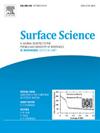氮原子在HfC和TaC(001)表面的吸附:第一性原理研究
IF 1.8
4区 化学
Q3 CHEMISTRY, PHYSICAL
引用次数: 0
摘要
用第一性原理计算研究了氮原子在HfC和TaC(0 0 1)表面的吸附。采用(√2 ×√2)R45°超级单体板计算0.5层覆盖时的吸附。在我们的计算中,交换相关势用修正版的Perdew-Burke-Ernzerhof (RPBE)泛函来处理。我们的研究结果表明,N原子的吸附是一个大的放热过程,表明N原子与(0 0 1)表面之间的相互作用很强。N原子的首选吸附位点是(0 0 1)表面的MMC (M = Hf或Ta)位点。Mulliken电荷、键居数和态密度(DOS)的结果表明,N/HfC(001)中的N - c键比N/TaC(001)中的N - c键具有更多的共价特征。同时,N-Ta键比N-Hf键表现出更多的共价特征。与O原子与(0 0 1)表面的相互作用相比,N原子与HfC(0 0 1)表面的共价相互作用弱,而N原子与TaC(0 0 1)表面的共价相互作用强。本研究结果可为HfC和TaC热防护材料的进一步开发提供基础信息。本文章由计算机程序翻译,如有差异,请以英文原文为准。

Adsorption of nitrogen atom on the (001) surface of HfC and TaC: A first-principles study
First-principles calculations are performed to investigate the adsorption of nitrogen atom on the HfC and TaC (0 0 1) surface. The (√2 × √2) R45° supercell slabs are employed to calculate the adsorption at 0.5 monolayer coverage. In our calculations, the exchange-correlation potential is treated with the revised version of the Perdew-Burke-Ernzerhof (RPBE) functional. Our results show that the adsorption of N atom is a large exothermic process, indicating the interactions between N atom and the (0 0 1) surfaces are strong. The preferred adsorption site of N atom is MMC (M = Hf or Ta) site on the (0 0 1) surfaces. The results from Mulliken charges, bond population and density of states (DOS) demonstrate that N–C bonds in N/HfC (0 0 1) has more covalent characters than that in N/TaC(001). Meanwhile, N–Ta bond exhibits more covalent characters than N–Hf bond. Compared with the interactions of O atom and the (0 0 1) surfaces, the covalent interaction of N atom and the HfC (0 0 1) surface is weak, while the interaction between N atom and the TaC (0 0 1) surface is strong. Our results may provide basic information intended as a reference for the further development of HfC and TaC thermal protection materials.
求助全文
通过发布文献求助,成功后即可免费获取论文全文。
去求助
来源期刊

Surface Science
化学-物理:凝聚态物理
CiteScore
3.30
自引率
5.30%
发文量
137
审稿时长
25 days
期刊介绍:
Surface Science is devoted to elucidating the fundamental aspects of chemistry and physics occurring at a wide range of surfaces and interfaces and to disseminating this knowledge fast. The journal welcomes a broad spectrum of topics, including but not limited to:
• model systems (e.g. in Ultra High Vacuum) under well-controlled reactive conditions
• nanoscale science and engineering, including manipulation of matter at the atomic/molecular scale and assembly phenomena
• reactivity of surfaces as related to various applied areas including heterogeneous catalysis, chemistry at electrified interfaces, and semiconductors functionalization
• phenomena at interfaces relevant to energy storage and conversion, and fuels production and utilization
• surface reactivity for environmental protection and pollution remediation
• interactions at surfaces of soft matter, including polymers and biomaterials.
Both experimental and theoretical work, including modeling, is within the scope of the journal. Work published in Surface Science reaches a wide readership, from chemistry and physics to biology and materials science and engineering, providing an excellent forum for cross-fertilization of ideas and broad dissemination of scientific discoveries.
 求助内容:
求助内容: 应助结果提醒方式:
应助结果提醒方式:


